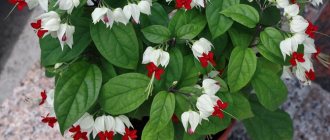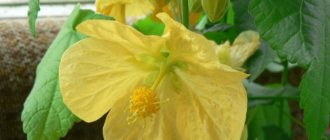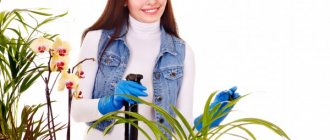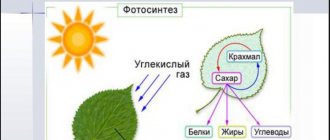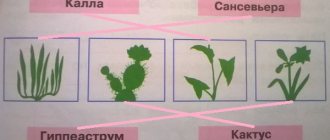What are home grown white flowers with a red center called?
A houseplant with white and red flowers is called clerodendrum. The complex name of this plant translates as “tree of fate.” There is a Javanese legend associated with it that clerodendrum brings happiness. A distinctive feature of these plants are their unusual flowers that take the shape of a butterfly.
Clerodendrum Thomson
Thomson's clerodendrum is a woody vine with fast-growing shoots. This plant is a rare guest in Russian apartments. The most common variety was Prospero. It is distinguished not only by its flowers, but also by its leaves, which look like thick branches. The aroma of blooming clerodendrum has jasmine notes - for this feature the vine was nicknamed “nodding jasmine” by the Japanese.
Description
Clerodendrum blooms in the summer season. The first flowers appear in June, and in September the plant begins to prepare for hibernation. But if we consider the Fragrant Clerodendrum, it is capable of blooming all year round with proper care. The aroma of the plant comes not only from the buds, but also from the leaves. The smell may vary depending on the variety.
The leaves of the vine reach a length of 20–30 centimeters. The shoots of the plant quickly become woody during the period of active growth.
Flower growers note the following features of clerodendrum:
- The shape of the bush is adjusted by pinching and pruning. The plant can be bush-like, ampelous or standard.
- The flower surprises with its unpretentiousness and endurance. During the dormant period, it does not freeze even at a temperature of twelve degrees.
- As the bush matures, it needs to be replanted less frequently. A young plant changes pots once a year. Mature - once every 3-4 years.
Care
During the growing season, clerodendrum needs periodic watering. It is necessary to spray the plant with a spray bottle in the evening. The bushes tolerate soft, settled water well. The frequency of watering is determined by temperature conditions. On hot summer days, the vine needs frequent watering. At other times, hydration is reduced. To determine a flower’s need for moisture, just look at the soil.
Important. In order for the flower to be preserved over the winter, it must be protected from all heating devices. Despite hibernation, clerodendrum may suffer from excessive dry air. Overdrying the earthen clod will result in the death of the plant.
Flower growers begin to fertilize clerodendrum in the second half of April. To saturate the plant with microelements, two feedings per month are enough. Complex fertilizer for flowering indoor plants is used as fertilizing. During the hibernation months, the bush does not need fertilizers.
Clerodendrum requires periodic pruning to adjust growth. Two types of pruning are applied to the plant:
- Rejuvenating. During rejuvenation, weak and dried shoots are removed. Healthy stems are shortened by a third to stimulate growth. If you follow the pruning rules, the bushes will produce young, fast-growing shoots. Inflorescences will begin to actively form on these shoots.
- Formative. A dense crown is the key to the health and beauty of the plant. If a gardener wants to turn clerodendrum into a bush, in the spring he will need to greatly shorten the stems. To give a flower a stem shape, it must be removed from all shoots except one - the strongest. To form the crown, all upper stems are pinched.
Clerodendrum needs frequent soil renewal. It quickly absorbs all nutrients and depletes the substrate. Another reason for replanting is that the pot is cramped: if there is not enough space, the plant will wither. The transplant should coincide with the beginning of the growing season. If the grower plans to prune the bush, this task must be completed before replanting.
The bush is suitable for fertile soils with a slightly acidic reaction. You can buy the substrate at the store or prepare it yourself.
The following components will be needed for the soil mixture:
- coarse sand;
- peat;
- clay and leafy soil.
Important. Before planting clerodendrum, the substrate must be disinfected. For these purposes, gardeners use ovens, ovens or microwaves.
When transplanting, the exact sequence of actions must be followed:
- A drainage layer 3 centimeters high is poured onto the bottom of the pot.
- The flower is lowered into the pot using the transfer method. During transplantation, you need to try not to damage the earthen ball.
- The voids in the pot are filled with prepared substrate.
- After compacting the earth, the bush is watered.
If the plant requires support, it is installed during transplantation. If you stick a stick into the soil mixture later, there is a risk of damaging the root system.
Diseases of Guzmania
Guzmania rarely gets sick, only when conditions of detention are grossly violated. If the watering schedule is violated, if the root system is watered with cold tap water, or if the ambient air humidity is low, diseases are inevitable. Here are some of them.
- If gray spots appear on the leaves, this is a fungal disease gray rot . Treatment is carried out with fungicides. Read the instructions; you may have to treat the plant more than once.
- Excess moisture in the leaf rosette can cause the flower to wither, as well as rotting of its base and root collar.
- Lack of water in the outlet and too dry air in the room will cause the tips of the leaves on Guzmania to begin to dry out.
- Sunburn leads to the appearance of dry brown spots and dried, curled tips on the leaves.
- Spraying with hard cold water will lead to the formation of a white limescale coating on the leaves.
- If the temperature of the flower is too low, its leaves begin to droop and become soft.
- If you overwater the substrate, the roots may rot. You will have to remove the flower from the pot, remove the affected parts of the roots, treat the wounds with activated carbon, smother them, and plant the flower in a new substrate.
- Sometimes Guzmania stops growing and does not bloom. Perhaps you have not fed it for several years, or it is growing in a dark place, it does not have enough lighting, or the air in the room is dry and its leaves do not have enough moisture. If you provide her with proper care, your Guzmania will certainly grow and bloom.
- After the flowering of Guzmania, no children appeared. Perhaps you did not cut the peduncle and waited until the seeds ripened. And this process significantly slows down the process of process formation. If the flower lives, cut off the peduncle and wait for the babies to appear.
Flowers with large leaves
Flowers that differ in the size of their leaves include:
- Anthurium. The leaves of this plant reach a length of 30 centimeters. Flowers with a yellow erect inflorescence and a bright red petal that resembles a sail. Anthuriums are light-loving flowers that do not get along with drafts and coolness.
- Spurge. Euphorbia leaves are dark green in color. Their length ranges from 10 to 15 centimeters. The deep red petals are shaped like the pointed leaves. This plant blooms during the winter months.
- Vallota. Wallot leaves are pointed and sword-shaped. They can reach half a meter in length. They come in a dark green shade, which turns into dark red towards the base. With proper care, the plant blooms twice a year.
- Clerodendrum. The leaves of the plant grow up to 30–35 centimeters and have the shape of a vine. The plant itself has become famous due to the unusual color of its flowers, which combines red and white.
The meaning of guzmania and its effect on the atmosphere in the house
Those who have just acquired the plant are interested in guzmania itself and what this flower means. When it comes to plants of the tropics, the literature often contains fascinating legends or signs associated with the properties or history of a particular culture. One thing is well known: in the homeland of the plant, guzmania is recognized as a symbol of male strength and, being next to a representative of the stronger sex, invigorates and actively affects male longevity. Unfortunately, there are no more informative stories about guzmania, but bioenergetics scientists studying the effect of plants on humans can tell a lot about this home flower.
A plant with shiny elongated leaves and a striking bract at the top is a wonderful decoration for home and office, as well as an effective air purifier.
People will feel a positive effect on energy and tone everywhere, but at home this effect is most noticeable. As an indoor flower, Guzmania will help you get rid of painful depression, improve sleep and have a beneficial effect on the general condition of the body. Not only does the sight of bright, living foliage have a positive effect on your emotional background and quality of sleep, it calms you down and puts you in a good working mood. Admiring the “blooming” of guzmania promotes an influx of energy and awakens creative abilities.
Feeding, fertilizers, hygiene
Experienced gardeners know that anthurium should be fed in spring and summer. Fertilizers for orchids will suit him well. Feeding is done about 2 times a month. It is necessary to wipe the leaves from dust with a damp cloth 2 times a week. Experts recommend giving the flower a warm shower once every 3 months. In addition, you should promptly prune inflorescences that have faded.
Clerodendrum – “tree of fate”, bringing good luck
The name “clerodendrum” means “tree of fate”.
It has another name - Volkameria - “innocent love”. Signs and superstitions are associated with the beautiful flower, which prophesy happiness to the home. Blooming clerodendrum really makes you think about fate and love. Volkameria prefers tropical and subtropical climates and lives on the African continent, Asia, and Australia. Under natural conditions it grows in the form of shrubs or vines. Some species are represented by trees that shed their leaves when the dormant period begins. This article will tell you how to care for clerodendrum.
The magical properties of poinsettia
How Poinsettia affects people:
- helps revive marital love, makes relationships passionate and bright;
- helps to replenish the family: it is recommended to keep it for spouses who are unable to have a child;
- gives pure energy of joy, helps drive away depression, despondency and blues, it has the power to maintain a good mood, create a warm atmosphere, attract new opportunities for positive emotions;
- improves the well-being of the inhabitants of the house, increases enthusiasm and vitality (it will help a sick person to recover faster);
- attracts well-being and prosperity - in the spiritual and material aspects;
- helps to assimilate knowledge, concentrate, think creatively and generate new ideas - a person thinks faster, is less tired of intellectual work, works efficiently and with pleasure.
In addition, the flower protects from negative energy: the evil eye, damage, external bad influence, internal conflicts and fears. Only pleasant and friendly people come to the house where poinsettia grows, but those who are hostile here become uncomfortable. The atmosphere in the family becomes warm and friendly, and the financial situation stabilizes.
What should you do if the plant does not bloom?
Pensettia flower in the house: how to care for the leaves to turn red? You need to take into account all the unsuitable moments for this plant. Because if at least 1 unfavorable factor affects it, then the flowering period will be delayed. In the fall, up to 8 weeks, milkweed needs a period when the dark stage takes up to 15-14 hours a day. Even short-term exposure to sunlight or artificial light can lead to unpleasant consequences. At night the plant is comfortable at 15-16 degrees, and during the day at 21-22.
When winter has just begun and the buds on the plant become noticeable, it is transferred to normal mode. Care as usual. Sunlight and watering should be more abundant.
If the gardener did everything correctly and did not allow even a slight impact of adverse factors on the milkweed, the plant will damage it with its flowering at Christmas Russian holidays.
Propagation and pruning
The flower must be divided every 3.5 years. It does not live in pots alone for more than this period. Usually they divide it into 2 parts (so that the new plant is lush) or into several parts at once. A sign of this is the dropping of leaves.
There are 2 ways to propagate Anthurium: cuttings and seeds. Method 1 . It is necessary to cut the stem upward and place it for rooting in a small container with moist soil. Method 2 . To do this, you need to sow the seeds in moist soil. But before that, you need to keep them for about 1.5 hours in a weak solution of potassium permanganate to prevent mold, placing them in a warm place. It is worth noting that they take a long time to germinate. The first shoots appear only after 2 months. After small anthuriums grow 6 centimeters, they need to be planted in separate containers. The seeds can be soaked first by placing them on damp foam, which should be kept constantly wet. When the seeds germinate, they are planted in the ground. Usually the plant is not pruned. Flower growers remove only those leaves that have lost their attractiveness.
Is it possible to keep poinsettia at home?
This is a very beautiful flower with gorgeous blooms and great energy. You can and should keep it at home, but you need to remember some features. This plant belongs to the euphorbia species, the milky juice of which is poisonous (although in this case less so than that of other varieties). If it gets into the stomach, it can cause poisoning, irritation on the skin, and burns on the mucous membrane.
Therefore, you should not have it in a house where there are small children, and as for pets, they have a good sense of smell and avoid dangerous vegetation. Some cats still eat poinsettia and, judging by the reviews of their owners, without visible harm. However, it is better to place the flowerpot away from those who want to chew the leaves. Even if the cats are not harmed, the damaged plant may refuse to bloom.
It is better to carry out pruning, replanting and cuttings with gloves and careful attention so that the juice does not splash into your eyes (to be on the safe side, you can wear safety glasses). Energy and care Only a healthy and flowering plant has positive energy.
In poor conditions and without proper care, it will begin to broadcast not benign “emotions”. Therefore, it is worth starting it only in those houses where it will be properly looked after.
There are a few important rules to remember:
- Do not overwater the flower - like all euphorbias, it does not tolerate waterlogging;
- To keep the bracts bright, fertilize them with a special composition;
- After flowering, when the leaves fall, prepare the plant for the dormant period: cut the stems, stop feeding and reduce watering;
- Starting from October, organize a “short day” regime for two months: at about 17-00, cover the flower with a dark bag and transfer it to the closet, and early in the morning put it on the windowsill - this will stimulate the formation of buds and beautiful “stars” will appear just in time for the winter holidays.
Sources and literature
Sources and literature
- Bernardino de Sahagun, Kuprienko S.A. General history of the affairs of New Spain. Books X-XI: Knowledge of the Astecs in medicine and botany / Ed. and lane S. A. Kuprienko.. - K.: Vidavets Kuprienko S. A., 2013. - 218 p.
- Beketov A. N. Dicotyledons // Encyclopedic Dictionary of Brockhaus and Efron: in 86 volumes (82 volumes and 4 additional). - St. Petersburg, 1890-1907.
- Paul E.Ranch “The Poinsettia and its legend”, Chicago, 2001
- Klug, S., Saleem, G., Hocharuk, L., Marcus, S. Toxicity potential of poinsettia, is the plant really toxic? Ottawa, 1990.
- Taylor, Judith M.; Lopez, Roberto G.; Currey, Christopher J.; Jan, Jules. The Poinsettia: History and Transformation // Chronica Horticulturae. - 2011. - T. 51, No. 3. - P. 23-27.
Poinsettia in summer
From the end of May, the indoor poinsettia flower enters the stage of active growth. At the beginning of this period, the plant can be replanted.
Caring for a flower with such a beautiful name - Christmas star - implies:
- good lighting;
- moderate watering;
- temperature range 15-25˚С;
- fertilizing with humus or universal fertilizer.
With the onset of stable heat, the plant can be taken out to the balcony (garden).
As soon as the active growth of shoots begins, you need to begin to form a bush. Cut poinsettia branches can be used for propagation by cuttings.
Home care
The plant should be properly cared for, then it can grow up to about 70 cm in height and 1.5 meters in width, while blooming almost all the time. After the flower is at home, it should be placed in a bright and warm place. It is important that the place allocated for it is not too “hot”. It takes about 11 days to get used to home conditions. During this time, soil moisture is taken under control. The plant should be sprayed with warm water every day. Avoid getting drops on the bract. After this, the flower must be transplanted into fresh soil. It is recommended to very carefully inspect the roots and free them from the manufacturer's substrate. Then carefully get rid of the sponge, which is usually located between the roots.
Poinsettia in autumn
Proper care of the wonderful flower called the Christmas star in the fall is important if you want to see it bloom just in time for the merry New Year holidays.
The difficulty is that poinsettia under natural conditions begins to bloom after the time of year with the shortest daylight hours. It lasts for about two months.
The plant should be illuminated 9-10 hours a day.
At the end of September, to simulate such conditions, the pot is placed in a non-residential building, where artificial light is not turned on in the evening and in the morning. If there is no such place in the apartment, then the flower will have to be hidden under an opaque box or film from evening until morning.
During this period, the plant should be watered regularly, as soon as the soil in the pot is half dry. Once every 7-10 days the plant needs to be fed with a composition for flowering plants.
